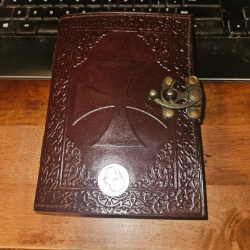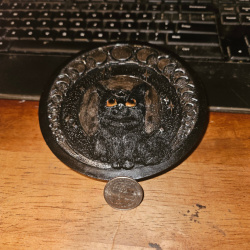Latest Products
-
 Knights Templar Leather Journal
$50.00
Knights Templar Leather Journal
$50.00 -
 Sacred Eye Journal
$50.00
Sacred Eye Journal
$50.00 -
 Black Cat with Moons Incense Burner
$15.00
Black Cat with Moons Incense Burner
$15.00 -
 Witch's Brew Mug w/ Spoon
$13.00
Witch's Brew Mug w/ Spoon
$13.00
Hawthorn Leaf and Flower - Crataegus monogyna
1 Oz
$3.00
Hawthorn leaves, flowers, and the berries have been praised over the centuries for their heart elevating properties. Believed to uplift and strengthen both the physical and emotional heart, hawthorn, as it supports healthy cardiovascular function, was also revered for ceremonial and spiritual purposes.
Hawthorn has been used since the Middle ages, with some accounts going back as far as the first century to Greek herbalist Dioscorides. It was later used by Swiss physician Paracelsus (1493–1541 CE). Considered to be a particularly symbolic tree with many folktales and magical myths surrounding it, hawthorn was "sacred tree medicine" to the ancient Druids, and was said to house fairies, specifically when growing with oak and ash trees. However, it was unlucky to bring the flowers into the house, quite possibly because they would bring the fairy folk with them. Hawthorn twigs and flowers were incorporated in the marriage wreath symbolizing chastity and insuring prosperity at Greek weddings and were also used to decorate alters worshipping the goddess of marriage, Hymen. In Ireland, couples desiring hawthorn's blessing would dance around it at marriage ceremonies. The sprigs were attached to newborn's cradles to protect them from evil, and also used to decorate the maypole for the May Day or Beltane ceremony, which celebrated fertility and renewal. The blooming of this tree coincided with the first day of summer which occurred in May. In the traditional medicine of Europe all parts of the tree were appreciated and utilized: leaves, berries, flowers, and the wood. The blossoms were used as a heart tonic and a diuretic, and the berries and leaves were made into an astringent tea to soothe throats. The bright red sumptuous berries were also made into a tasty brandy cordial. Additionally, the wood was carved into smaller objects such as boxes and combs and burnt as fuel producing wood fires that were extremely hot.
Hawthorn or 'shanzha' has been used in traditional Chinese medicine (TCM) since ancient times, however most historical uses were related to digestion until recently. It is considered energetically slightly warm, associated with the spleen, stomach, and liver meridians, and reflects both sweet and sour tastes. Presently, it is used to support the cardiovascular system as well, and in fact, in China, the berries are so popular that they are made into hawthorn candies that are similar to the 'fruit roll-ups' in the West. Hawthorn is considered a superior heart tonic by many herbalists. However, its effects on the heart are manifold. Many consider hawthorn to be transformational for the emotional or spiritual heart as well. Herbalist Matthew Becker suggests that hawthorn is specifically helpful for women with "broken hearts" i.e. for those " feeling wounded and hurt." Often the flowers and leaves are made into floral essences to address these types of emotional issues.
Hawthorn has been used since the Middle ages, with some accounts going back as far as the first century to Greek herbalist Dioscorides. It was later used by Swiss physician Paracelsus (1493–1541 CE). Considered to be a particularly symbolic tree with many folktales and magical myths surrounding it, hawthorn was "sacred tree medicine" to the ancient Druids, and was said to house fairies, specifically when growing with oak and ash trees. However, it was unlucky to bring the flowers into the house, quite possibly because they would bring the fairy folk with them. Hawthorn twigs and flowers were incorporated in the marriage wreath symbolizing chastity and insuring prosperity at Greek weddings and were also used to decorate alters worshipping the goddess of marriage, Hymen. In Ireland, couples desiring hawthorn's blessing would dance around it at marriage ceremonies. The sprigs were attached to newborn's cradles to protect them from evil, and also used to decorate the maypole for the May Day or Beltane ceremony, which celebrated fertility and renewal. The blooming of this tree coincided with the first day of summer which occurred in May. In the traditional medicine of Europe all parts of the tree were appreciated and utilized: leaves, berries, flowers, and the wood. The blossoms were used as a heart tonic and a diuretic, and the berries and leaves were made into an astringent tea to soothe throats. The bright red sumptuous berries were also made into a tasty brandy cordial. Additionally, the wood was carved into smaller objects such as boxes and combs and burnt as fuel producing wood fires that were extremely hot.
Hawthorn or 'shanzha' has been used in traditional Chinese medicine (TCM) since ancient times, however most historical uses were related to digestion until recently. It is considered energetically slightly warm, associated with the spleen, stomach, and liver meridians, and reflects both sweet and sour tastes. Presently, it is used to support the cardiovascular system as well, and in fact, in China, the berries are so popular that they are made into hawthorn candies that are similar to the 'fruit roll-ups' in the West. Hawthorn is considered a superior heart tonic by many herbalists. However, its effects on the heart are manifold. Many consider hawthorn to be transformational for the emotional or spiritual heart as well. Herbalist Matthew Becker suggests that hawthorn is specifically helpful for women with "broken hearts" i.e. for those " feeling wounded and hurt." Often the flowers and leaves are made into floral essences to address these types of emotional issues.
- Availability: 12 In Stock






